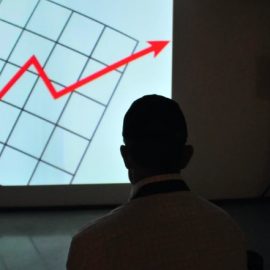
This is a free excerpt from one of Shortform’s Articles. We give you all the important information you need to know about current events and more.
Don't miss out on the whole story. Sign up for a free trial here .
What’s causing the record-high credit card debt in America? Why are Americans spending so much yet saving so little?
Credit card debt in America rose to $890 billion in 2022, with total household debt hitting a record high of $16.5 trillion. Credit is a survival tool for most Americans—and the debt tied to it is so ubiquitous in the U.S. that it’s become normalized.
Read on to learn more about credit card debt in America, including tips for managing debt.
Debt in America Is Rising Rapidly
For many Americans, the new year came with resolutions to put their best foot forward—and the rude awakening of holiday spending hangovers, rising inflation rates, and the looming threat of a recession. January may be a month of personal finance reckoning as credit card debt in America reaches an all-time high.
Despite a challenging economic forecast for 2023, many Americans spent the past year charging up a storm and going into debt while doing it: In the second quarter of 2022, total household debt hit a record high of $16.5 trillion, with credit card debt ringing in at $890 billion—up from $790 billion a year earlier.
In this article, we’ll examine the factors contributing to the record credit card debt and spending in America, what lies ahead in 2023, and tips for paying down debt.
Americans, Credit, and Spending
The relationship between spending and credit card debt is complicated in America, which is understandable given the mixed messages around the subject and the realities of daily life for most.
On the one hand, financial guru and author of The Total Money Makeover, Dave Ramsey, argues that you don’t need a credit score. He and other experts warn against falling into the trap of paying extra money in credit card interest each month, which can add up quickly and is part of the reason so many Americans are up to their ears in debt right now.
On the other, experts say that credit is a basic survival tool for most Americans, enabling those who can’t afford to pay for everything in cash to pay for otherwise unattainable items like security deposits, a home mortgage, or medical emergencies.
The Problem With Credit: Debt
Most financial experts agree that the problem with credit is debt from late interest fees when people fail to pay their bills on time and in full—and credit card debt in America is so ubiquitous that it’s become normalized. In 2022, 60% of Americans reported carrying monthly credit card debt for at least a year (up 10% from a year earlier), 40% for two years, and 28% for three.
Strikingly, debt in 2022 soared amid an economy that, while booming, was rife with supply chain issues that pushed up the cost of goods and saw some of the highest inflation rates in fifty years. Even the threat of a recession atop the pocketbook pain caused by these realities didn’t stop Americans from spending up a storm while starving their savings accounts.
Why the Record Spending and Debt in the U.S.?
Experts offer different theories on why spending and credit card debt have been sky high and rising in America:
- With 10 million job openings and unemployment at a near-50 year low, Americans haven’t felt the pressure to save money and build a financial cushion.
- The debt increase sources from rising interest rates on credit cards, increased spending on travel and leisure, and soaring costs of day-to-day and emergency expenses, from groceries, childcare, and utilities to home and auto repairs and medical bills.
- Debt has crept up on Americans who, spending as usual and not attuned to inflation and rising interest rates, have been shocked to discover they’re in debt.
What Will Spending and Debt Look Like in 2023?
Experts fear that Americans may be in for a world of financial woes in 2023, with a possible perfect storm of a recession, falling numbers of job openings, rising unemployment rates, and stubborn inflation challenges. Some express wary optimism that the bulk of Americans, unlikely to experience layoffs in the near future, will weather the storm.
Need to Clear Your Debts?
In his book The Automatic Millionaire, David Bach offers a powerful action plan for clearing your debts, which could be a helpful tool for many in America facing the stress of rising credit card debt. He argues that, if you’re in debt, you should prioritize clearing the amount before you build your savings account. This is because the interest you earn in your savings account is far less than the interest you pay towards your debts. To clarify, if you owe $2,000 in credit card debt and just make the minimum monthly payments, it will take you more than 18 years, and a total of $4,600 to pay off your balance. The same $2,000 held in a savings account earning 1% will only total $2,392.29 after 18 years. Therefore, you’ll save far more money if you clear your debts first.
(Shortform note: It’s true that clearing debts before you build your safety net will save you more money in the long term. However, if your job situation is insecure, some financial experts advise that you should prioritize your savings before you clear your debts. This way, you’ll avoid getting into further debt if you do lose your job—you won’t have to rely on your credit cards to survive because you’ll have savings to fall back on.)
Your Debt-Clearing Plan
We’ve broken the process down into four distinct steps: total up your balances and interest, make commitments, reduce your payments, and prioritize your debts.
(Shortform note: Sethi’s debt-clearance plan differs from Bach’s method and provides some contradictory advice—we’ll compare Sethi’s process to Bach’s throughout each of the four steps.)
Step 1: Total up your balances and interest: If you’re currently in debt, you’ll need to total up the balances you owe and the amount of interest you’re paying on top of this balance.
(Shortform note: Sethi advises that you should call up your credit companies to find out how much debt you owe, how much interest you’re paying, and the minimum monthly payment. He claims that many people are unaware of exactly how much debt they’re in so need to speak to their debtors before they can come up with a plan to clear their debts.)
Step 2: Make commitments: Don’t buy things you can’t afford (property is the only exception as it tends to appreciate in value), and refuse to use credit cards—cancel them and remove the temptation to use them.
(Shortform note: Both Bach and Sethi advise that you don’t buy things you can’t afford, but they differ on what methods you should use to pay for what you buy. In contrast to Bach, Sethi suggests that you keep your credit cards as they’ll improve your credit history—make use of them but always pay your balance off in full. This way, you show lenders you can be trusted to pay back the money you borrow.)
Step 3: Reduce your payments: Contact your credit card company and ask if they can lower the rate of interest you’re paying, or consolidate all of your payments—move multiple debts to a single low-interest account. In addition, automate your payments to avoid paying late fees.
(Shortform note: In addition to consolidating and automating your payments, Sethi argues that you should negotiate lower interest rates regardless of whether you’re in debt or not. This will reduce your chances of getting in debt if you ever fail to pay off your balance.)
Step 4: Prioritize your debts: If you choose not to consolidate your payments, pay off your debts one by one. Bach suggests you divide the balance of each debt by the minimum payment required—this will show you the number of payments you need to make to pay off the debt. Next, rank your debts so that the lowest number of payments is on top. Prioritize paying off the debt at the top of your list while you continue to pay the minimum balance for your remaining debts.
(Shortform note: Sethi also suggests that you commit to paying off one card at a time while using automated payments to pay the minimum balance for the rest of the debts. However, he believes you have two options for doing this: prioritize the cards with the highest interest, or use Dave Ramsey’s “snowball method” to prioritize paying off cards with the lowest balance (regardless of the interest they charge). He advises that you should plan to make more aggressive payments until you clear your debts.)
TITLE: The Automatic Millionaire
AUTHOR: David Bach
TIME: 45
READS: 94.8
IMG_URL: https://www.shortform.com/blog/wp-content/uploads/2021/10/the-automatic-millionaire-cover.png
BOOK_SUMMARYURL: the-automatic-millionaire-summary-david-bach
AMZN_ID: XYZ

Want to fast-track your learning? With Shortform, you’ll gain insights you won't find anywhere else .
Here's what you’ll get when you sign up for Shortform :
- Complicated ideas explained in simple and concise ways
- Smart analysis that connects what you’re reading to other key concepts
- Writing with zero fluff because we know how important your time is






